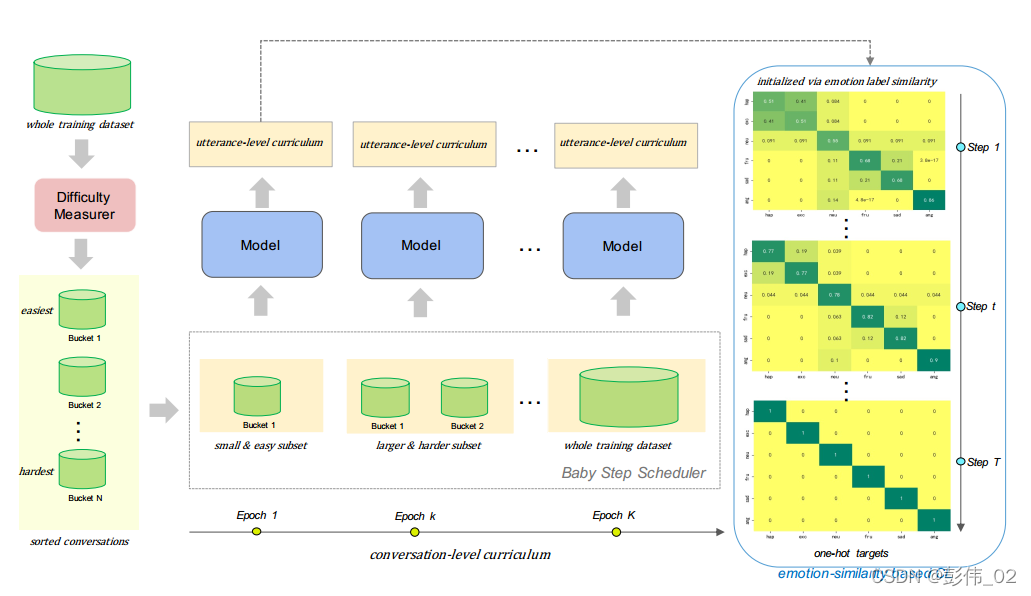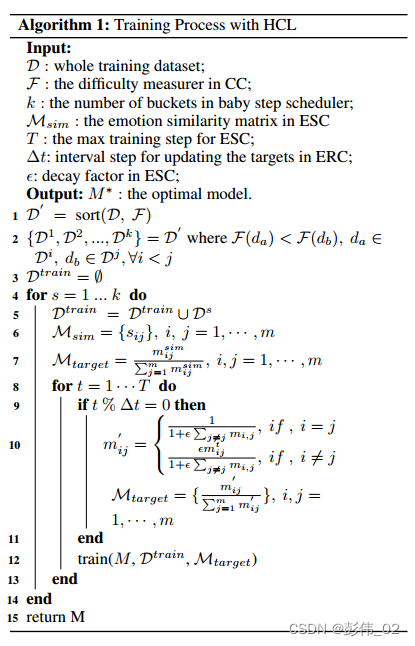Hybrid Curriculum Learning for Emotion Recognition in Conversation
改论文发表于2022 AAAI,阿里巴巴团队,旨在用课程学习解决对话情感识别
动机:
Motivated by recent studies which have proven that feeding training examples in a meaningful order rather than considering them randomly can boost the performance of models, we propose an ERCoriented hybrid curriculum learning framework.
贡献:
- We propose a hybrid curriculum learning framework to tackle the task of ERC. At conversation-level curriculum, we utilize an emotion-shift frequency to measure the difficulty of each conversation.
- We propose emotion-similarity based curriculum learning to achieve utterance-level curriculum learning. It implements the basic idea that at early stage of training it is less important to distinguish between similar emotions compared to separating very different emotions
- 理解一下:在训练的早期,对于识别不同的情感比识别区分相似的情感更重要。所以文章的方法为啥能达到这种效果?
- 实验结果的有效性,实现了SOTA
方法:
(1) conversation-level curriculum (CC) – we construct a difficulty measurer based on “emotion shift”frequency. The conversations are scheduled in an “easy to hard” schema according to the difficulty score returned by the difficulty measurer.
(2) utterance-level curriculum (UC). it is implemented from an emotion-similarity perspective, which progressively strengthens the model’s ability in identifying the confusing emotions

UC很容易理解,就是常规的课程学习方法;UU的动机是说一个对话中的句子是具有逻辑性的,顺序是无法改变的,怎么解决这个问题呢?
作者assuming that the utterances with confusing emotion labels are more difficult for prediction;
and our utterance-level curriculum is based on the pairwise similarities between the emotion labels.
见下图:

首先计算一个情感矩阵:

进行归一化之后,得到目标情感矩阵概率分布,然后计算loss:

我理解的这个loss和之前的model相比应该就是增加了一个
M
t
a
r
g
e
t
M_{target}
Mtarget?,可是和动机的关系是?没太理解。
整个过程的训练算法如下:

问题总结:
第一,对于动机2着实没理解透彻,为啥引入一个
M
t
a
r
g
e
t
M_{target}
Mtarget?,可以起到课程学习的作用?解决方法和motivation之间的关联性是什么?
第二,对于算法中的第9~11行之间的矩阵的更新,我的理解是让这个矩阵对角线上逐步趋近于1,然而这个更新的方式也是没太明白。
有看明白的同学可以解惑一下,感谢!
更多有趣文章见:
利用逆向思维的机器阅读理解
证据推理网络
Bert预训练模型-中文文本分类